Healthy Living
New report “sheds light on darkness”
January 25, 2011

Increasing numbers of Los Angeles County residents are finding themselves in a blue state. And it has nothing to do with political affiliation.
A new report from the Department of Public Health shows that 13.6% of adults in the county report having been diagnosed with depression at some time in their lives—an increase of nearly 50% between 1999 and 2007. The rates went up for all adults, but the increases were most pronounced for those from 25-29 and 60-64. The condition continues to affect more women than men (16.6% compared to 10.3%) and is more common among whites and African Americans (17% and 16.6% respectively) than Latinos (12.4%) and Asians/Pacific Islanders (6%.)
The report said that those who have been diagnosed with depression are likelier than others to smoke and drink heavily and to get less exercise. It found that more than 35% of those who said they’d been diagnosed with depression also had chronic health conditions such as diabetes, heart disease and obesity. And it reported that many in the county said they’d been unable to afford mental health care or counseling when they needed it.
Some of the increase in reported depression can be attributed to greater public awareness of depression and better diagnosis of the problem, as well as to a possible decrease in stigma attached to the condition, said Dr. Susie Baldwin, chief of the department’s Health Assessment Unit, which produced the report.
Even so, depression represents a huge personal and social challenge.
“From any perspective, depression takes a large toll in terms of disease burden, and is the most common mental health problem. We need to ensure that those suffering from depression get diagnosed early and receive timely care,” Dr. Jonathan E. Fielding, the county’s Director of Public Health, said in a press release.
“The takeaway is that this is very common and not something that is the fault of the individual,” Baldwin added. She noted there are many ways to help—from family members being patient with a depressed loved one to public policy-makers providing funding for mental health programs. The report also lists several recommendations for things employers and companies can do to help with depression in their workforce.
The report emphasizes that the best way to fight depression is to get help from a mental health professional. It said that free and low-cost help is available and urged anyone who needs it to call the county Department of Mental Health hotline, (800) 854-7771. Other resources listed include the Didi Hirsch Mental Health Services agency, which has a 24-hour suicide crisis line (877-727-4747), along with community outreach programs and other assistance available.
The report draws on information gathered as part of the L.A. County Health Survey, conducted every three years from thousands of randomly-selected telephone respondents. Because it does not include the worst years of the economic recession, it does not indicate whether increasing financial stresses, including job losses and home foreclosures, are pushing depression rates even higher in Los Angeles County.
Those factors will be examined in the 2010 survey, with initial results not expected until early 2012. “It’s going to be interesting when we get the new data,” Baldwin said. The next report also will indicate how many people are currently feeling depressed—not just whether they’ve ever been diagnosed in the past.
Posted 1/25/11
Flu season’s weighty new issue
January 19, 2011
 As this year’s flu season in Los Angeles claims its first victims, medical officials are increasingly focusing on obesity as a risk factor for the virus.
As this year’s flu season in Los Angeles claims its first victims, medical officials are increasingly focusing on obesity as a risk factor for the virus.
Three people have died in the county so far this flu season—a 48-year-old man, a 29-year-old woman and a 4-year-old boy. Both of the adults who died were obese, and all of the victims died from an influenza strain that can be prevented by the flu vaccine, public health authorities said. They urged flu shots for everyone over the age of six months to help protect them during a fast-moving flu season that is expected to accelerate through February and continue into the spring.
Unlike last year, when there were highly-publicized vaccine shortages and widespread public concern about H1N1, commonly known as the swine flu, this year’s influenza season seems to be attracting less attention so far.
But it can be just as dangerous.
And, as the cases involving this season’s first Los Angeles County victims show, obesity could play a role in how seriously the highly contagious virus plays out.
A Public Health department analysis of last year’s flu season, when the H1N1 pandemic was in full swing, shows that obesity was the No. 1 risk factor cited in those who died of the flu in Los Angeles County, followed by “underlying pulmonary, metabolic and cardiac conditions.” The vast majority of the 149 people whose deaths were officially attributed to last season’s flu—88%–had some kind of underlying medical condition, the analysis said. Overall, health officials estimate that the average flu season results in about 1,000 deaths a year in the county, although it is listed as the official cause of death in only some of them.
Last year’s flu season was unusual in that older people—those who are typically considered most likely to die from the flu—experienced fewer deaths and complications than younger people, probably because the elders are believed to carry greater immunity to H1N1. In L.A. County, last season’s flu proved most deadly to those between the ages of 50 and 64. Latinos had the highest rates of intensive care hospitalization and death, while Asians had the lowest. And young children were the most likely to be hospitalized for the disease, but the least likely to die from it.
The link between obesity and H1N1 complications is increasingly well-documented. A recently published scientific paper studied 534 California patients hospitalized for H1N1 during the 2009 flu season and found that half of them were obese—and that those who were the most obese were the most likely to die from the flu.
“I think it is just more evidence to the story that obesity is not just a social condition. It is a medical condition that has risks,” said Dr. Janice K. Louie, head of the surveillance and epidemiology section of the California Department of Public Health and the lead author of the study. She said that anyone with a high body mass index—greater than 30 and particularly greater than 40—should treat flu season very seriously. “If your BMI is 35 or higher, you really should be very aware that influenza is very severe and can kill you. And you should get your flu shot.”
The Centers for Disease Control recently added morbid obesity to its list of medical conditions that place someone at high risk of flu complications. The others include asthma, cancer, diabetes, heart disease and HIV/AIDS; the full list is here. Others at high risk include pregnant women, children under 2 and adults 65 and older.
Flu shots and nasal mist flu vaccine are widely available. People can get the inoculations through their personal doctor or local pharmacy. They also can find a vaccination clinic by checking Public Health’s immunization program website, by accessing the Find-A-Flu-Shot locator, or by calling 2-1-1.
Whatever your risk factor, public health officials say that getting a shot is the responsible thing to do both from an individual and a community health perspective. And they point out that all of the old common sense rules of the season still apply: covering coughs and sneezes, washing your hands frequently and staying home from work or school if you’re sick.
“That’s probably the best way we can stop the spread of the disease,” said Dr. Robert Kim-Farley, director of Communicable Disease Control and Prevention for Los Angeles County. It may not be easy to call in sick in this economic climate—but it’s the right thing to do. “Employers out there should recognize that this is beneficial to them,” Kim-Farley said. “It’s self-enlightened for them to have a healthy workforce.”
Posted 1/19/11
A small request from Fido and Fifi
January 13, 2011
 If you won’t quit smoking for yourself, do it for your four-legged pals.
If you won’t quit smoking for yourself, do it for your four-legged pals.
That’s the message from the county’s Department of Public Health, which says that second-hand smoke is more hazardous to your pets than you might realize. Animals who live with smokers get a chemical-laden residue in their fur or feathers and suffer higher cancer rates as a result, public health officials said.
“Pets living in a smoker’s home not only inhale smoke. They also eat it every day when they groom their fur or feathers,” the department said in a public service announcement. Smokers’ pets also may develop problems with breathing and irritation of the eyes and skin.
If you’re ready to quit smoking, check out this list of frequently asked questions on the Public Health website. Your pet will lick you for it.
Posted 1/13/11
Keep that resolution now – ask us how!
January 6, 2011

Quit smoking! Stop drinking! Earn more! Owe less! Get that degree while shedding 10 pounds of belly fat!
If these are among your New Year’s resolutions, we’d suggest one more: buyer beware. For as surely as the ball drops in Times Square, scammers are gearing up to take advantage of your good intentions.
So how can you maintain your resolve in 2011 while steering clear of pitfalls? We asked Rigo Reyes, acting director of the county’s Department of Consumer Affairs, whose experts looked at some popular resolutions and offered these tips.
 Get healthy. “We see a lot of weight-loss programs,” says Reyes, whose team recently has been forwarding complaints and inquiries to the California Medical Board about lap band surgery. But that’s just one get-healthy-quick pitch among many. Faith healers in bogus farmacias prey on Spanish-speaking consumers who want to quit drinking or smoking or overeating. And every year, Reyes says, he hears from couch potatoes who bought sales pitches from some gyms without actually reading the high-priced contracts. “People need to read the fine print and not just believe promises,” says Reyes. Short cuts are imaginary and costly. A walk around the block, on the other hand, is free.
Get healthy. “We see a lot of weight-loss programs,” says Reyes, whose team recently has been forwarding complaints and inquiries to the California Medical Board about lap band surgery. But that’s just one get-healthy-quick pitch among many. Faith healers in bogus farmacias prey on Spanish-speaking consumers who want to quit drinking or smoking or overeating. And every year, Reyes says, he hears from couch potatoes who bought sales pitches from some gyms without actually reading the high-priced contracts. “People need to read the fine print and not just believe promises,” says Reyes. Short cuts are imaginary and costly. A walk around the block, on the other hand, is free.
 Get out of debt. “This is a top priority for a lot of people in this economy,” says Reyes. But beware of credit repair scams and offers of foreclosure assistance and debt consolidation. No one can legally remove accurate information from a credit report, and if the information is inaccurate, you can get it removed for nothing. If you’re having foreclosure troubles, deal directly with the bank or get help from a HUD-approved nonprofit—don’t waste money on for-profit intermediaries. As for debt consolidation offers, Reyes says many leave consumers with high fees, unpaid debts and worse credit. Scams such as these have become so predatory that new laws have been passed to address them. Up-front fees are now illegal for credit repair, loan modification and foreclosure assistance in California. A new federal telemarketing rule also prohibits them for debt consolidation services offered through phone sales. If you really need help, Reyes says, contact the Consumer Affairs Department at (800) 593-8222 or (213) 974-1452: “We’ll help you out for free.”
Get out of debt. “This is a top priority for a lot of people in this economy,” says Reyes. But beware of credit repair scams and offers of foreclosure assistance and debt consolidation. No one can legally remove accurate information from a credit report, and if the information is inaccurate, you can get it removed for nothing. If you’re having foreclosure troubles, deal directly with the bank or get help from a HUD-approved nonprofit—don’t waste money on for-profit intermediaries. As for debt consolidation offers, Reyes says many leave consumers with high fees, unpaid debts and worse credit. Scams such as these have become so predatory that new laws have been passed to address them. Up-front fees are now illegal for credit repair, loan modification and foreclosure assistance in California. A new federal telemarketing rule also prohibits them for debt consolidation services offered through phone sales. If you really need help, Reyes says, contact the Consumer Affairs Department at (800) 593-8222 or (213) 974-1452: “We’ll help you out for free.”
 Get a job. If the jobless rate is any indication, millions of Californians share this resolution. But employment scams are already worsening life for the desperate. “A lot of them are phishing schemes and bogus mystery shopper programs—you get an email from people claiming to be ‘recruiters’ who can get you a job if you just give them your information, which then leaves you vulnerable to identity theft.” Some of these job scammers go further. They send bogus checks to people to purportedly finance their “start-up” costs. The victims are told to deposit the checks and wire back a portion to third parties. Because the law requires banks to make the funds from the deposited check available before the check completely clears, the scammers get away with the money, which the bank will try to collect from you.
Get a job. If the jobless rate is any indication, millions of Californians share this resolution. But employment scams are already worsening life for the desperate. “A lot of them are phishing schemes and bogus mystery shopper programs—you get an email from people claiming to be ‘recruiters’ who can get you a job if you just give them your information, which then leaves you vulnerable to identity theft.” Some of these job scammers go further. They send bogus checks to people to purportedly finance their “start-up” costs. The victims are told to deposit the checks and wire back a portion to third parties. Because the law requires banks to make the funds from the deposited check available before the check completely clears, the scammers get away with the money, which the bank will try to collect from you.
 Get a degree. Great resolution, but only if you can use the diploma, so look out for unaccredited and for-profit schools. “The private post-secondary bureau in the state Department of Consumer Affairs used to license these schools, but the legislation authorizing it was allowed to sunset three years ago,” says Reyes. “People are trying to re-establish it, but in the meantime, there has been a free-for-all.” If you want to take classes or get job training, he says, apply to an accredited university, enroll at a community college or check out adult education programs at your local high school. “The Evans Adult School, which is part of the Los Angeles Unified School District, has a very comprehensive program,” says Reyes, “and you don’t have to pay anything but $5 for a student I.D.”
Get a degree. Great resolution, but only if you can use the diploma, so look out for unaccredited and for-profit schools. “The private post-secondary bureau in the state Department of Consumer Affairs used to license these schools, but the legislation authorizing it was allowed to sunset three years ago,” says Reyes. “People are trying to re-establish it, but in the meantime, there has been a free-for-all.” If you want to take classes or get job training, he says, apply to an accredited university, enroll at a community college or check out adult education programs at your local high school. “The Evans Adult School, which is part of the Los Angeles Unified School District, has a very comprehensive program,” says Reyes, “and you don’t have to pay anything but $5 for a student I.D.”
Posted 12/05/11
Seven tips for safe and sound holidays
December 15, 2010
This time of year can be such a mixed bag, and not just for Santa. There are great parties all over town—but has the guy in the next lane had a few too many? Is that glittering Christmas tree a tinderbox waiting to happen? And how’s the pet of the house expected to know that chocolate and poinsettias can be hazardous to his health?
If all this is starting to sound more like a minefield than a holiday, relax. Los Angeles County’s resident experts are here to help.
Their tips will help you navigate the pitfalls of the season—from the basics (driving sober) to the more arcane (making sure you’re not overcharged at the cash register.) They’ll even help you score a free bus ride on New Year’s Eve.
1. Don’t drink and drive.
This is rule No. 1 for a reason. Sheriff’s officials implore you to do the right thing, which means not getting behind the wheel if you’ve been drinking. If you need any reminders of the possible consequences, Sgt. Joseph Jakl, supervisor of the sheriff’s Traffic Services Detail, thinks this YouTube video from the city of Santa Clarita sums it up nicely. So designate a driver, call a cab or use public transportation if you choose to imbibe. (To make things easier, all Metro trains and buses are free on Christmas Eve and New Year’s Eve starting at 9 p.m.)
2. How to spot a drunk driver.
Jakl says to watch out for vehicles making overly wide turns, straddling the lane line, swerving, and randomly speeding up or slowing down. If you see someone who appears intoxicated and whose driving is endangering others, get the license number if you can do so safely and call 911 or your local police agency. The sheriff’s department and other law enforcement agencies also are planning DUI checkpoints across the county, through the holiday season and beyond.
If you have pets—or are planning on getting one at a “Happy Pawlidays” adoption on Saturday, Dec. 18–be aware that many of the hallmarks of the season, from shiny ornaments and treated Christmas tree water to candies and seasonal plants can be dangerous to animals. “While we are caught up in the hustle and bustle of the season, we may overlook some of the pet safety hazards,” says Evelina Villa, a spokeswoman for the Animal Care & Control department. A full list of the department’s holiday pet safety tips is here.
4. Practice safe shopping.
If you shop online, don’t tempt thieves by letting deliveries stack up on your front porch, says Lt. Scott Chew of the Malibu/Lost Hills sheriff’s station. Instead, he suggests having your packages delivered to your work address or to a neighbor who’s going to be at home during the day. Chew says it’s also common for people to leave expensive items like iPads and purses in their cars—an invitation to criminals year-round but particularly now. “Unfortunately, this time of year, there are people in the parking lots who are watching you,” Chew says. More tips, courtesy of the Santa Clarita Valley sheriff’s station, are here.
5. Check your receipt.
The Department of Weights and Measures wants to remind you to make sure that the amount you pay at the cash register matches the posted or advertised price. “Routine inspections reveal that overcharge errors do occur and often involve items with special promotional offers, ‘sales,’ and markdowns for which price information has not been updated in the scanner system,” the department said in a news release. “Holiday shopping presents many opportunities for such errors.” Here’s how to report an overcharge. And for a video report on the subject, check out this from the L.A. County Channel.
6. Scam artists don’t take the holidays off.
Bogus phone solicitations often crop up at this time of year, like this reported “green toilet scam” in Calabasas. And some would-be bargain hunters recently were victimized after setting out to meet someone advertising an “incredible price” for a camera on Craigslist. Instead, suspects in ski masks blocked their car and robbed them. Authorities advise skepticism and caution.
7. Keep the wrapping paper out of the fireplace.
County fire officials have put together this holiday tip sheet with advice on choosing, decorating and maintaining an indoor Christmas tree. They also say you should never burn wrapping paper in the fireplace; doing so “can produce dangerous sparks and a chemical buildup in the home that could cause an explosion.” Finally, they suggest getting an early jump on those New Year’s resolutions by making sure all of your smoke detectors are in good working order. Cheers!
Posted 12/15/10
L.A.’s diabetes epidemic gets worse
November 4, 2010
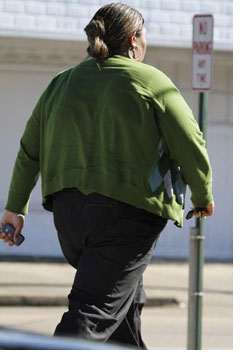 Diabetes in Los Angeles has hit an all-time high, with a new public health report showing that 9.1% of adults have Type 2 diabetes, which usually is caused by obesity.
Diabetes in Los Angeles has hit an all-time high, with a new public health report showing that 9.1% of adults have Type 2 diabetes, which usually is caused by obesity.
The report covers the years from 1997, when the figure was 6.6%, to 2007.
“It is unacceptable that so many people are suffering from a disease that, in most cases, can be prevented or controlled,” said Dr. Jonathan E. Fielding, the county’s director of public health. “Exercising regularly, making healthy eating choices and controlling or reducing weight can help prevent, control or even reverse diabetes.”
In a press release, Fielding noted that diabetes is the 6th leading cause of death in the county and a contributor to the No. 1 killer, cardiovascular disease.
The report, Trends in Diabetes: A Reversible Public Health Crisis, was issued in conjunction with the American Diabetes Association of Los Angeles.
County health officials will take part in the diabetes association’s “Feria de Salud” on Olvera Street in Downtown Los Angeles. The event will take place on Sunday from 10 a.m. to 3 p.m.
Posted 11/4/10
Really cutting the fat in government
October 20, 2010
There was trouble lurking behind the scenes at the Compton Courthouse.
Doughnuts. Homemade banana bread. Deep fried cafeteria treats. And a healthy dose of rivalry to see who could do the best job of avoiding all that unhealthy stuff and the unwanted pounds that go with it.
Deputy Alternate Public Defender Connie Quinones and her self-named squad of Hub City Hotties knew the competition would be stiff when they set out to become L.A. County’s biggest losers.
“The clerks were really out to beat us,” Quinones recalled.
But armed with pedometers, brown bag lunches and the workout ethic necessary to conquer the 12-story courthouse’s stairs, the Hub City Hotties helped the Alternate Public Defender’s Office prevail in its long-shot bid to win the countywide contest.
Going up against much larger departments such as the Sheriff and Health Services, the tiny, 281-employee Alternate Public Defender’s Office (which takes on clients in cases where the Public Defender has a conflict of interest) fielded three teams. Together they lost 4.4% of their body weight and took top honors in the 8-week contest. The next best performance came from the coroner’s department (3.4% lost) and the Chief Executive Office (3.3%).
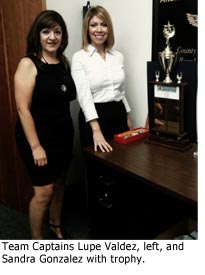 A total of 6,441 employees from virtually every county department took part, losing a total of 23,085 pounds—more than 11.5 tons. All the top teams were honored at the Board of Supervisors’ meeting Tuesday, but only one went home with the trophy.
A total of 6,441 employees from virtually every county department took part, losing a total of 23,085 pounds—more than 11.5 tons. All the top teams were honored at the Board of Supervisors’ meeting Tuesday, but only one went home with the trophy.
Quinones, an avid fan of “The Biggest Loser” TV show and regular user of superstar trainer Jillian Michael’s website, bought a new scale and set it up in her department’s conference room in Compton. Weigh-ins were serious business.
“There was no honor system,” said Quinones, a 19-year county veteran who lost 9 pounds during the two-month contest. “They had to have a witness when they weighed in.”
Those who gained a pound or ducked a weigh-in to hide their dietary missteps were fined $1 or $5 respectively. (Quinones used the proceeds to buy prizes she distributed randomly to team members.)
The Hotties encouraged and supported each other, brown bagging it in the conference room, exchanging ground turkey recipes and even meeting up on weekends for power walks at the beach or in Signal Hill.
Even so, success was not assured.
“I let a couple of court reporters and bailiffs join us and they gained!” Quinones said. “One gained 10 pounds!”
Fortunately, another one of the Alternate Public Defender’s teams, the eight-member Long Beach squad that dubbed itself Strong Beach, lost 7.5% of its body weight and helped put the entire department over the top.
That meant that Strong Beach captain Lupe Valdez got first dibs on bringing the trophy to Long Beach. It also will be displayed in Compton before coming downtown to central headquarters, where it will remain.
For now.
After the board ceremony, Valdez and Quinones treated themselves to a celebratory lunch of chilaquiles (definitely not on the Jillian Michaels eating plan) at El Tepeyac, east of downtown. There, they ran into some other county competitors who vowed: “Next year, we’re going to get that trophy from you.”
To which Valdez and Quinones replied: “OK, it’s on!”
Posted 10/20/10
Game on at El Cariso
October 6, 2010
Heads up, El Cariso Park-goers: Get ready to kick it in new ways at your favorite 79-acre spread.
A multi-year, multimillion dollar renovation and building initiative is underway at the county park, set against a striking mountain backdrop in Sylmar. The latest components—including two new artificial turf soccer fields and a cutting edge “universal play area”—were approved Tuesday by the Board of Supervisors.
And there’s much more on the horizon: an $11.5 million gymnasium/community building with indoor basketball facilities, a full kitchen, an onsite office for sheriff’s deputies and gathering spaces for park-users, which is welcome news for a seniors’ group that now must meet elsewhere. A contractor has been selected to design and build the new structure, with groundbreaking expected to take place early next year. The job is set to finish in 2012.
Also on tap for the park is a “Smart Garden Learning Center,” where people from the community can learn the fine points of composting and environmentally sound landscaping techniques. The center is scheduled to open in February.
 All this comes on top of a slew of other improvements in recent years that have included: a $5.8 million renovation of the park’s swimming pool facilities; new water-saving irrigation measures in the park and on its golf course; upgraded restrooms, drinking fountains, picnic areas and walkways; and the installation of a park fitness zone featuring outdoor gym equipment.
All this comes on top of a slew of other improvements in recent years that have included: a $5.8 million renovation of the park’s swimming pool facilities; new water-saving irrigation measures in the park and on its golf course; upgraded restrooms, drinking fountains, picnic areas and walkways; and the installation of a park fitness zone featuring outdoor gym equipment.
The amenity infusion means
more park to love for people like
Alina Mendizabal, whose family has made heavy use of El Cariso over the years.
“Basically, my children grew up there,” said Mendizabal, who works at Olive View-UCLA Medical Center and frequently volunteers at the park. Her husband, she said, “lives at the tennis courts.” After neck surgery earlier this year, she took part in water aerobics classes at the newly renovated pool. Her husband even had a (short-lived) side business selling ice cream in a truck outside the park. And now, even though she’s still in her 40s, she’s already looking forward to hanging out in the park’s new community center when she enters her retirement years.
“That’s where we’re going to be all the time,” Mendizabal recently told her husband.
El Cariso provides a “safe, healthy, playful environment, with caring, dedicated staff,” she said. “I always see my neighbors. It’s our community park.”
More than any amenities, she credits the people who work at El Cariso with “making us feel welcome, making us feel valued.”
Her only complaint? “We do need more lighting. That is one thing we do need. It’s really dark in the back on the walking trails.”
El Cariso, designated a county community regional park, is the only one of its kind in the 3rd District.
It was named in honor of the El Cariso Hotshots, an elite interagency firefighting crew that lost a dozen members battling the devastating Loop Fire in 1966.
The park attracted 534,563 visitors last year—a figure that’s expected to jump by 15% to 20% when the new, 15,000-square-foot gym/community center is completed.
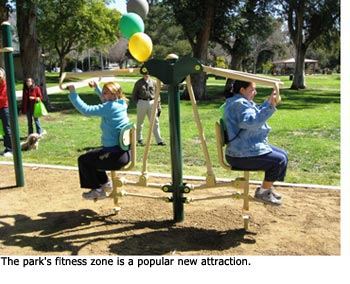 Altogether, the recent and upcoming projects at the park represent an investment of more than $34 million, according to a tally provided by the county Department of Parks and Recreation.
Altogether, the recent and upcoming projects at the park represent an investment of more than $34 million, according to a tally provided by the county Department of Parks and Recreation.
Funding for the improvements comes from several sources, including Los Angeles County Proposition A bond funds, Proposition 40 state bond funds and various county monies.
The artificial turf soccer fields that were approved Tuesday, along with other improvements totaling nearly $11.5 million, are expected to attract new users to the park. So is the 54,000-square-foot universally accessible playground. Its concept was created in consultation with the advocacy group Shane’s Inspiration, which helps design playgrounds that all children can enjoy, even those in wheelchairs or with other disabilities. (Other such playgrounds are located at Griffith Park and Parque De Los Sueños in East Los Angeles.)
Even now, before these state-of-the-art elements are introduced at El Cariso, “the park gets used very, very well by the community,” said Sandra Chapman, the park’s supervisor. Looking ahead, she said, “I can just see it blossoming.”
Russ Guiney, director of the county’s Department of Parks and Recreation, said all of the recent and coming improvements have two goals in common: making the park better for the environment and better for the people who use it.
“All of this comes together,” he said, “to really make this one of the parks of the future.”
For a map showing where some of the new features will be located, click here.
Drop the salt and nobody gets hurt
September 22, 2010
 Don’t take this medical advice with a grain of salt.
Don’t take this medical advice with a grain of salt.
Los Angeles County public health officials say many of us are getting way too much sodium in our daily diets—most of it from processed food or restaurant meals. Those salty snacks and meals are feeding more than just hunger; they’re also fueling high blood pressure levels that are leading to serious health consequences here and across the country.
Jumping on board the National Salt Reduction Initiative led by New York City, county health officials are urging people to trim their salt intake by reading nutrition labels carefully, preparing more fresh foods at home and finding ways to cook with less salt.
If everyone in the county reduced their daily sodium content by 20%—about the amount found in a half cup serving of canned chicken noodle
soup—that would be enough to stave off 52,629 hypertension cases here and save $102 million in annual health care costs, county researchers say in a new report. As it stands now, the average Angeleno is consuming 50% more sodium each day than the 2,300 mg, or one teaspoon, that’s recommended. The advisable amount is lower (2/3 of a teaspoon, or 1,500 mg) for people with high blood pressure, those over 40 and African Americans, who are at higher risk for hypertension.
Cutting down “is worth doing. There’s no downside in reducing sodium,” says Dr. Tony Kuo, director the Public Health Department’s Office of Senior Health.
Salt intake has increased significantly over the past 30 years, contributing to widespread high blood pressure, which in turn can lead to problems ranging from heart attacks and strokes to kidney failure. Some 48% of county residents between the ages of 45 and 64 have hypertension, as do 65% of those over 65, the report says.
Troublingly, young people between the ages of 8 and 17 also are experiencing higher blood pressure these days, with the increases greatest among African American and Latino children.
The good news is that most diners won’t even notice what they’re missing if they phase out salt gradually. “The trick,” Kuo says, “is not to abruptly reduce the sodium.”
The department is even providing some links to low-salt recipes. Lemon and fresh herbs, anyone?
Posted 9/22/10




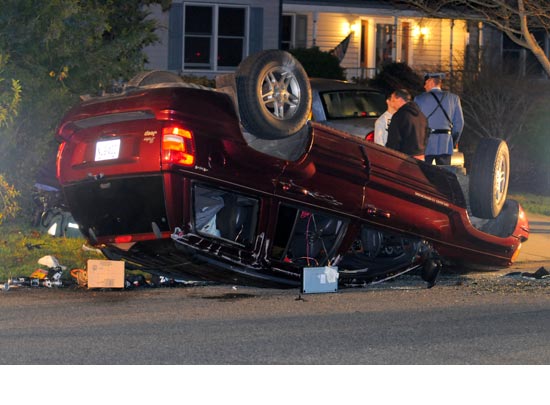


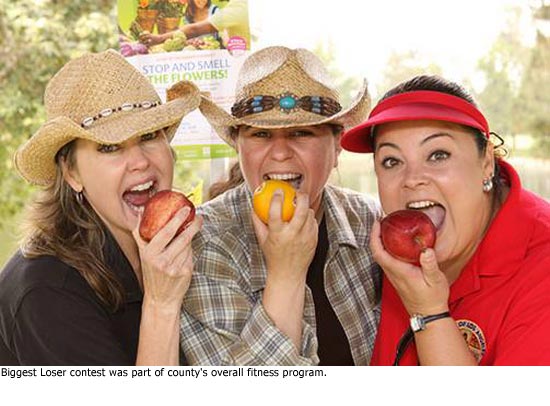
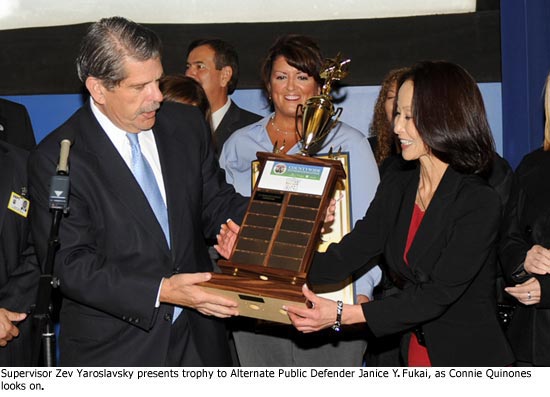









 405 bridge work causes a stink
405 bridge work causes a stink
